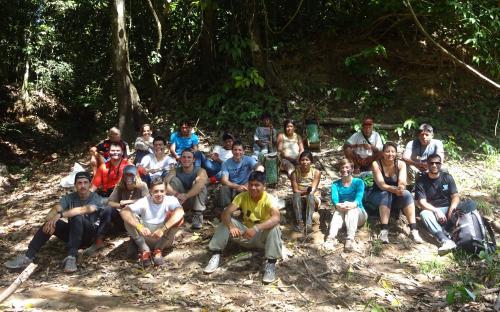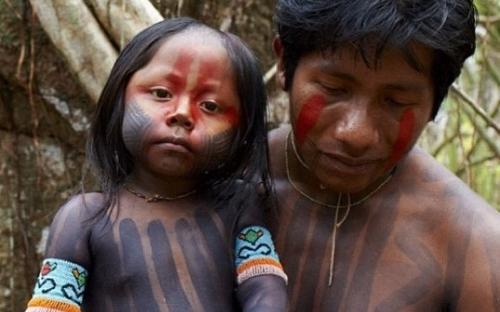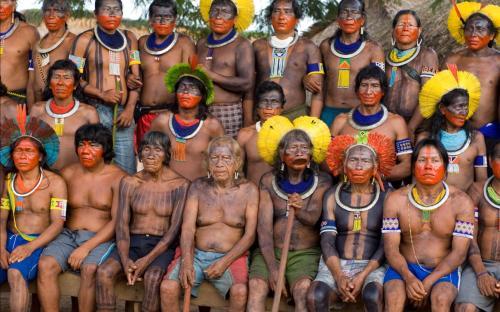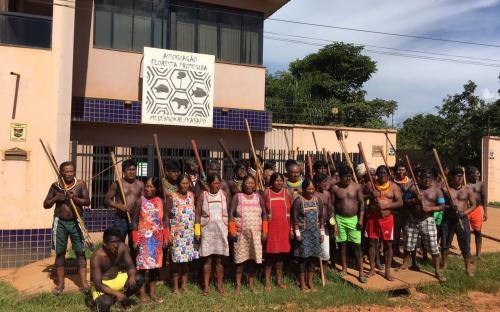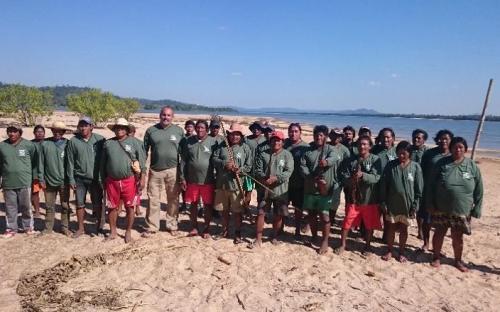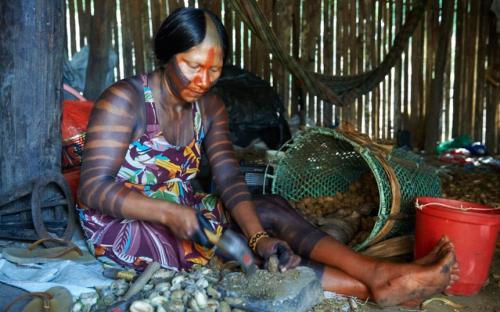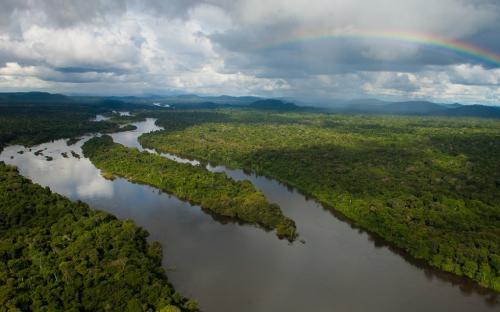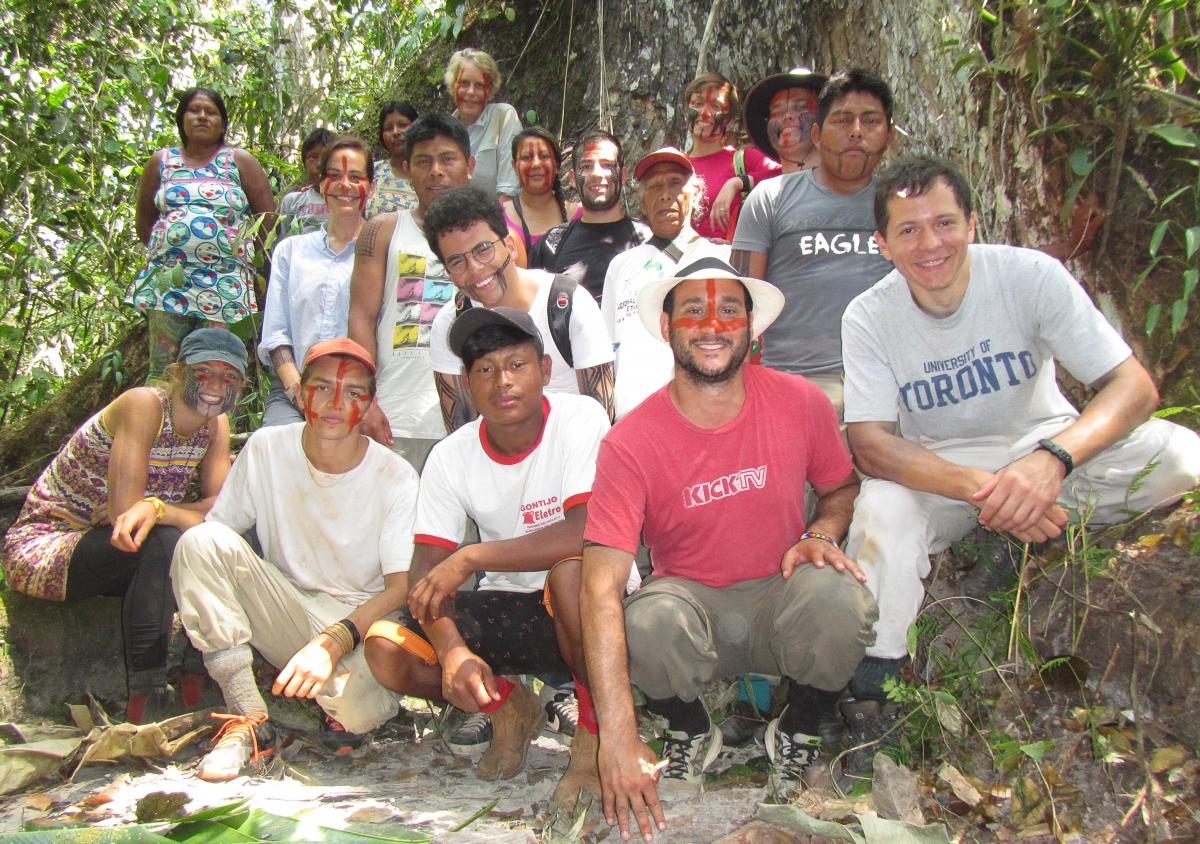 By Anna De Cheke Qualls
By Anna De Cheke Qualls
In 2015, doctoral student Matthew Aruch was traveling in a boat from the Pinkaiti Research Station in Brazil to A’ukre village in the Kayapó Indigenous Territory (TIK) of Pará, Brazil. The vessel was filled with people from all walks of life, and yet there was lots of lively, and harmonious conversation.
“There were Kayapó, anthropologists, conservation biologists, students, and interns from universities, and NGOs from the United States, Canada, Brazil, and Europe. Some were in the Kayapó area for the first time. Others had been working there for more than 20 years. I wondered where all these people had come from, and why they were there,” remembers Aruch, a student in the international education policy program.
Aruch was impressed, and fascinated by the transnational, and multicultural collaboration within what he has termed the 'Pinkaiti Partnership' – a slice of the larger Kayapó Project’s ecosystem. He decided to probe the nature, and evolution of this alliance – and, if it might not be a model for comparable collaboration between various entities, and indigenous people. For this line of research, Aruch was recently awarded a Fulbright Fellowship. Over the course of 9 months, the funding will allow him to explore the past, present, and future of the Pinkaiti Partnership from the perspective of its various stakeholders - the Kayapó community, NGOs, universities, governmental agencies, and institutions. With written approval from the indigenous leadership, Aruch’s research will take him to the city of Tucumã, and the village of A’ukre.
In these locations, Aruch will work closely with the Associacão Floresta Protegida (AFP), the Kayapó indigenous NGO that manages Pinkaiti, and a number of other sustainable development initiatives. He will identify, and link relationships among the important institutions, and individuals to the partnership, and also conduct interviews. “While I am mainly interested in interviewing key decision makers, research assistants, and field course instructors, the Pinkaiti Partnership is an important part of A’ukre’s community history. Therefore, I plan to invite all community members 18 years or older to participate in the project,” says Aruch. Moreover, at the request of A’ukre, Aruch will also implement various community workshops for children, and adults in order to help build capacity for new, and ongoing collaborations with Brazilians, and foreigners.
Aruch brings a wealth of knowledge to program development, as an experienced educator for more than 14 years. He has taught overseas in Honduras, and within the Virginia public school system. Since 2011, Aruch has been the Assistant Director of the College Park Scholars’ (CPS) Science Technology and Society Program. In this role, he has developed CPS’ Robotics Service-Learning Program, and managed the study abroad programs in Ecuador, and Brazil. These experiences according to Aruch, inspired “an interest in how education/research-based programming can be a vehicle for creating collaborative partnerships.”
But let’s go back a little bit. The beginnings of the Kayapó Project began in 1988, when Aruch was just 6 years old. Dr. Janet Chernela, an anthropologist at the University of Maryland, invited a Kayapó leader named Paiakan, and others to speak at an environmental conference in the United States. It was then that current Kayapó Project Director Dr. Barbara Zimmerman, then at Conservation International, had her first encounter with Paiakan. In 1991, then Chief Paiakan of A'ukre, had a second meeting with Zimmerman in Brazil. Through these connections, Zimmerman, Paiakan, and A’ukre set aside 8000 hectares of protected territory to create the Pinkaiti Research Station. At the time, A’ukre was under threat from illegal logging, and mining, and the Kayapó were looking for alternative, but viable economic programs. A’ukre agreed that no logging, mining or hunting was to be permitted on the Pinkaiti site. In turn, Zimmerman agreed to find Brazilian, and global research partners who would pay an access fee, and hire Kayapó research assistants. Some of the work between the Kayapó, and these researchers led to the creation of two critical indigenous NGOs - the AFP (2002) representing the northeast, and the Instituto Kabu (IK) (2008) in the northwest. The Instituto Raoni (IR) (2001) in the southwest was initiated by the world-renown Chief Raoni. The Pinkaiti Research Station remained active between 1992 to about 2004, and the resulting collaborative work was gaining attention, and support globally.
Around 2001, the community of A’ukre, Zimmerman, and Chernela shifted Pinkaiti’s focus from research to an international field course. Through this program, U.S. and Brazilian students were set up to visit A’ukre, and Pinkaiti for three weeks to learn about Kayapó culture, and tropical forest ecology. The foundations were also laid for a long-term model of community empowerment for forest protection. Over time, the partnership expanded to include – the AFP, Fundação Nacional do Índio (FUNAI), the University of Maryland, Purdue University, Universidade de Brasilia, Universidade Federal de Uberlandia, the Universidade Federal do Pará, the International Conservation Fund of Canada, and The Wild Foundation.
Today, over 100 million hectares of Brazilian Amazon is recognized as Indigenous Territories, of which 11 million belong to the Kayapó. Like the Native American cultures of North America, these communities lead a subsistence lifestyle, and organize based on common property, and egalitarian principles. The Kayapó continue to seek sustainable forms of income that are compatible with their need to preserve their lands, culture, and community equity. Increasing contact with outside society over the past 25 years has also led to dependence on certain manufactured goods that can only be obtained with money. As Brazilian citizens, the Kayapó seek entry into regional, and local economies, and the young seek access to technology, and education. They are currently involved in the production of Brazil nuts, cumaru nuts, fair trade handicrafts, and TIK field courses, and internships.
But the Kayapó's livelihood, and culture faces on-going threats from logging, ranching, gold mining, and governmental infrastructure.  Politically, the Kayapó are regularly pressured to open their lands to various business ventures, while remaining vulnerable to laws that aim to diminish the size of their territories. Since 1995, the Kayapó have maintained alliances with international conservation NGOs in order to strengthen their capacity for territorial control, and sustainable resource management as outside pressure on their lands, and culture continued to mount in the southeastern Amazon. As mentioned, they also formed their own regional advocacy organizations – the AFP, IK and IR. These indigenous NGOs have a common mission to obtain, and implement outside support for territorial protection, and control; gain insight into the plethora of intensifying threats they face, and development options; and organize/mobilize to defend their land, and constitutional rights.
Politically, the Kayapó are regularly pressured to open their lands to various business ventures, while remaining vulnerable to laws that aim to diminish the size of their territories. Since 1995, the Kayapó have maintained alliances with international conservation NGOs in order to strengthen their capacity for territorial control, and sustainable resource management as outside pressure on their lands, and culture continued to mount in the southeastern Amazon. As mentioned, they also formed their own regional advocacy organizations – the AFP, IK and IR. These indigenous NGOs have a common mission to obtain, and implement outside support for territorial protection, and control; gain insight into the plethora of intensifying threats they face, and development options; and organize/mobilize to defend their land, and constitutional rights.
According to Zimmerman, the role of these organizations is key to the success of the Kayapó Project. “These NGOs act as a bridge to, and outpost in a foreign national society with which the Kayapó must learn to deal in order to survive. Outside society will completely swallow the Kayapó, and their lands if they are not able to meet the outsiders on equal terms. These NGOs confer them capacity in the outside world by functioning within the laws, and procedures of western society to obtain, administer, manage, and implement outside support for territorial protection, sustainable development, and defense of indigenous rights. These NGOs give the Kayapó a voice in national society, and a seat at the table. The empowerment role of these Kayapó entities is starkly evident when one compares the roughly 10% of Kayapó territory not represented by high functioning indigenous NGOs with remaining Kayapó territory that is represented by NGOs. Lands of the non-represented Kayapó who therefore receive no outside conservation, and development investment are heavily invaded, and lost; whereas roughly 9 million hectares of territory represented by the AFP, IR, and IK continue to hold against the onslaught of ranching, logging, goldmining, and colonization in the lawless frontier,” she says.
Aruch’s research will be helpful in that it will elucidate the mechanism of local community empowerment (i.e. exactly how the AFP specifically works) that results in the protection of one of the world’s last great tracts of primary tropical forest, and the last stronghold for biodiversity in the entire southeastern Amazon. Says Zimmerman, “Empowerment of local communities that otherwise have no voice in national society seems to be the only way forward to save what remains of the world’s intact primary forest. And yet, there are precious few studies on how this local community mechanism actually functions to protect forests while benefitting people. Matthew Aruch’s research is particularly timely, and important because we face losing all of the world’s primary forests to logging, mining, and agriculture within a frighteningly short time span. International policy makers are searching for a way forward to saving at least some of the world’s richest, and irreplaceable forest ecosystems which generate so many sustainable benefits for local communities, and all of humanity but are being lost forever to illegal logging, and agriculture - usually for the short-term benefit of elites.”
Aruch is similarly excited about the implications of his research. “I look forward to sharing my Fulbright findings with the Kayapó of A’ukre, and international colleagues. I hope my research will provide government agencies, NGOs, academics, and indigenous groups in Brazil, and beyond with suggestions - on how education, and research can help to create or facilitate partnerships that maintain, and promote culture, livelihoods, but also protect the environment, and provide meaningful teaching, and learning opportunities,” says Aruch.
More information about Matthew Aruch can be found here.
(Photo Credits: Dr. Barbara Zimmerman, Martin Schoeller, IBAMA (Brazilian Ministry of Environment), Cristina Mittermeier, Andre D’Elia, Associacão Floresta Protegida (AFP), Adriano Jerozolimski, Matthew Aruch, Emily Colon, Dr. Laura Zanotti, Dr. Jorge Solórzano-Filho)
